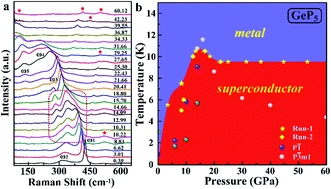Pressure-driven significant phonon mode softening and robust superconductivity in layered germanium phosphide†
Abstract
Recent discoveries in high pressure science have revealed entirely unexpected chemical behavior of two-dimensional (2D) materials. However, there is still a lack of unambiguous insight on the pressure-driven behavior of in-plane bonds in the 2D layered structures. Layered germanium phosphide (GeP5) is a metal with honeycomb-like sheets structurally similar to semiconducting black phosphorous, but with electrical conductivity ten times higher than that of graphite. Here, we report a remarkable pressure-dependent structural transformation that includes lengthening of the main in-plane bonds under pressure, although practically high pressure usually leads to shorter stiffer bonds. In situ Raman measurements show that there is significant phonon mode softening through the 2D–3D structural reconstruction, correlating with the in-plane bond extensions in GeP5 upon compression. This is accompanied by unusually superconducting behavior, on both sides of the transformation. This superconductivity with a maximum transition value of 10.5 K at 13.5 GPa shows a robust character without obvious reduction up to 60 GPa and is accompanied by pressure-induced amorphization in GeP5. Our experimental results, together with those from first principles calculations, not only provide the detailed high-pressure phase diagram of GeP5 but also connect the pressure-dependent bond extension with enhanced superconductivity.



 Please wait while we load your content...
Please wait while we load your content...
